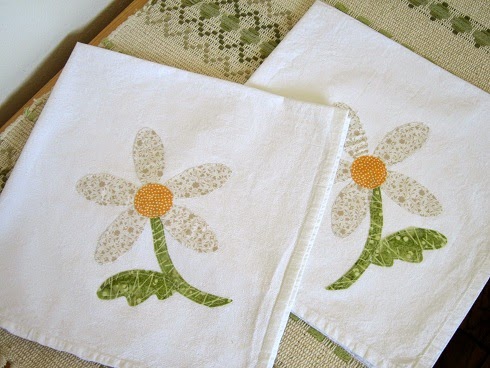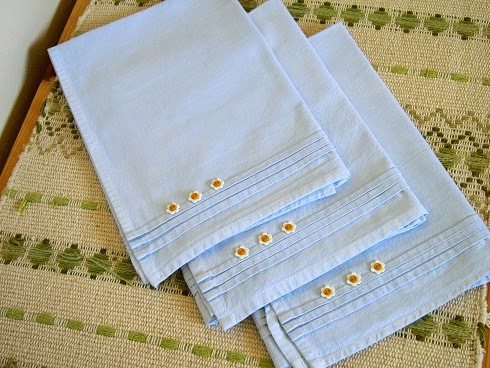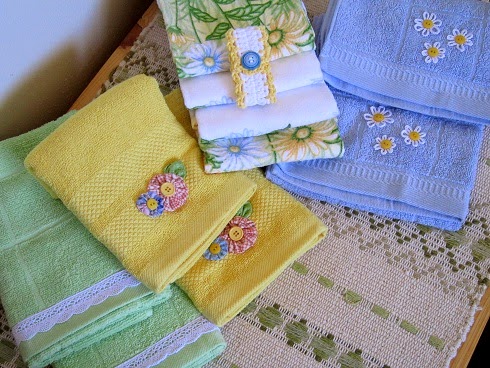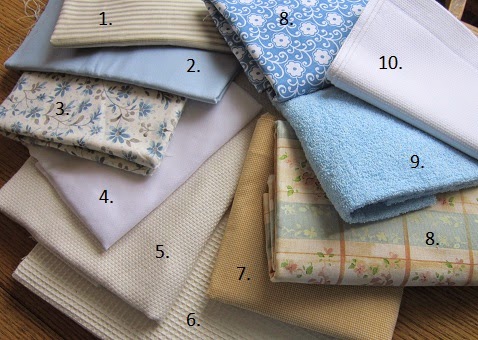I recently had an e-mail question about what kinds of fabric make good kitchen linens. This reader was interested in saving some money by sewing and decorating her own kitchen towels. I think this is a great question and thought perhaps more than she is interested in the subject.
The picture shows my favorite fabrics for making towels and other kitchen linens.
1. This is a soft "ticking" fabric. It is 100% cotton and usually 45 inches wide, sometimes 60 inches. It is called ticking because the twill weave and stripe pattern is typical of what is called pillow ticking - the fabric that used to cover pillows. There is a stiffer ticking - more like canvas, but you want to find the softer, towel-like fabric. I like to make kitchen hand towels from ticking and it works also for aprons. You can find ticking in the utility fabrics section of the store.
2. This is a plain weave fabric from the section of the fabric store called the "bottom weights." This is the fabric that is meant for making pants and skirts and other "bottom" garments. There are a number of choices for hand towels and aprons in the bottom weight section, but you want to be sure to look for 100% cotton fabric (or linen - but that would defeat the money savings wouldn't it!) The fabric could be either a plain weave or a twill weave - either one would work. Bottom weight fabric would also make nice place mats, napkins, or a small tablecloth.
3. Flannel makes a great kitchen hand towel. I like to sew two panels together to make it thick enough and then quilt or otherwise stitch it to hold it together. I like the many patterns and prints now available! Diaper flannel (if you can find it) and quilters flannel are sometimes a little thicker than regular flannel. The more you wash flannel, the better it gets. Flannel also works for dishcloths.
4. This is a piece of diaper fabric. You can buy diaper flannel, but diaper fabric is woven in a "birds eye" weave. It is 100% cotton and is 36 inches wide. Diapers, even the ones you buy already made (get the open, flat kind, NOT the pre folded ones) are truly wonderful dishtowels! I had a set in my own hope chest, painted with liquid embroidery by my cousin.
5. Monks Cloth is a thick, 100% cotton plain weave fabric that is usually 60 inches wide. The weave is very large and looks like huge cross stitch fabric. You can cross stitch on it and the pattern develops quickly! I also like to do Swedish Weaving on this fabric. It makes a very nice kitchen hand towel and maybe dishcloths as well. It would make a nice table cloth or place mats with cross-stitching.
6. This is a 100% cotton "waffle weave" fabric, sometimes called waffle weave muslin. It is also 60 inches wide. I love this fabric for making dishtowels and dishcloths, but you have to preshrink it even before measuring it as it shrinks so much. Just plan for that. It is a wonderfully thirsty fabric and lends itself to several kinds of decorating. You can see one example of hand made dishtowels
here and another one
here. The first link doesn't mention preshrinking. I certainly would do that first! Waffle weave fabric is found in the utility fabric section of the store, along with the muslin and ticking.
7. This is 100% cotton fabric called "homespun." This fabric makes really great dishtowels! I have several in my own kitchen drawer. Just be sure to get 100% cotton. You can find homespun with the quilting cottons in the fabric store. I have made
this and
this set for the hope chest so far.
8. These are two plain weave 100% cotton prints that I found in the "home dec" section of the fabric store. This fabric is often labeled dry clean only, but I use it for hand towels and aprons and place mats, napkins and tablecloths. I don't dry clean them. I usually just wash them on warm and dry on the clothesline. I understand that the fabric is labeled thus because the manufacturing is so variable that it might shrink (a lot or unevenly!) or it might "crock" (which means that heavily dyed fabric transfers excess dye to other fabric), or fade or exhibit any number of other problems. So I just take a chance because there are some wonderful choices in this section. I have never had any problems, but that doesn't mean you won't... When I make things for the hope chest, I try to always pre-wash and pre-shrink - so that fifteen years from now Abigail doesn't get a nasty surprise when she does laundry.
9. This is 100% cotton terry cloth. The width varies, usually 45 or 60 inches wide. It could used for hand towels and dishcloths. A pretty cotton print bias edging looks very pretty.
10. This fabric is called "huck" toweling or huckaback. It is narrow, usually only 15 inches wide and the edges are finished with a selvage. Huck toweling has a distinctive vertical raised thread in the weave and is most often used for Swedish Weaving decoration and other embroidery. It is soft and absorbent and makes a nice kitchen towel or tray cloth.
There is one more fabric that I use for dishtowels, but I didn't have any to put in the picture. Osnaburg fabric is found with the rest of the muslins in the fabric store and is a little bit thicker than regular muslin. It is more like homespun and it makes great dishtowels. It is 100% cotton, usually 45 or 60 inches wide and comes mainly in a natural darkish tan color. Osnaburg is a plain weave, so it frays nicely and it takes embroidery really well. It needs to be washed a couple of times before it is nicely absorbent.
Speaking of muslin, I have read that some people make dishtowels from muslin. I keep meaning to try - it is very inexpensive and would lend itself to many decorative techniques. When I look at it, though, it seems to be woven so tightly that I can't imagine that it would be very absorbent. Maybe someone has experience with it...
Just a quick comment about price. Sometimes new fabric can be more expensive than just looking for a good deal on ready-made linens. I always watch for the sales or use a 40% coupon to get the best deal, and usually have a stack of "hope chest" fabric in a stash, waiting for the next creative project!



























